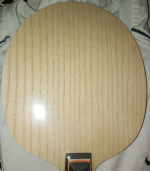The basics are above. I don't need to add this but I will anyway:
With the thicker sponge, theoretically, the ball can sink in more so the topsheet can grab more of the surface of the ball so you can get more spin. But the thicker sponge also ads more catapult when it rebounds so, less control for certain things. Also, to make a thicker sponge, useful you have to have more precise and more solid contact so you can get the ball to dig into the sponge more fully and so the topsheet can grab the ball more fully.
So, just the same way that hard, tacky rubbers reward bigger impact, thicker sponges do as well.
If you drive more than you loop slightly thinner sponge like 1.9 or 2.0 is better than max. If you are at that stage where you are learning to loop but the contact is not as consistent a thinner sponge is also preferable. If you mostly loop and your contact is well developed and your ball quality on your loop is high, so you get a lot of spin, that is when Max becomes more worthwhile.
Sent from TheSecretHideout using TheInfamousNSASpyPhone












